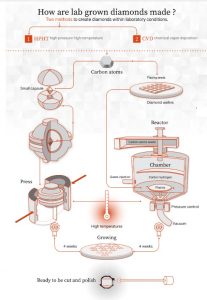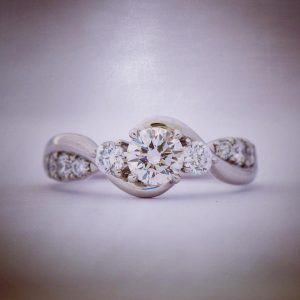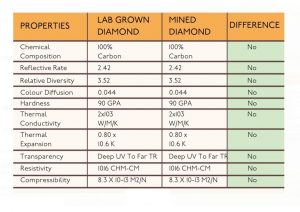LAB GROWN DIAMONDS
Lab Created Diamonds
What are Lab Grown Diamonds?
Lab grown diamonds have the same chemical, physical, and optical properties of natural diamonds. They’re made of pure carbon and have the same crystal structure as natural diamonds, which is why they are optically and physically identical to mined ones. The main difference between lab-grown and natural diamonds is their origin: lab-grown diamonds are created in a controlled environment, whereas natural diamonds are formed deep within the Earth over millions of years. Its an unthinkable achievement that man has been trying to crack the code of for many many years.
How are lab Created Diamonds made?
Lab grown diamonds, also known as synthetic diamonds, lab diamonds or cultured diamonds, are created using advanced manufacturing processes that simulate the natural conditions under which diamonds form in the Earth over millions of years. These processes typically involve the use of high-pressure, high-temperature (HPHT) or chemical vapor deposition (CVD) techniques to grow diamond crystals in a laboratory setting.

What are CVD Diamonds?
CVD diamond manufacture (Chemical Vapor Deposition) is a process of growing diamonds using chemical reactions in a low pressure environment. The process involves the following steps:
- A substrate material is prepared, usually a slice of silicon or other material with a flat surface.
- The substrate is placed in the reaction chamber, which is then evacuated and filled with a mixture of hydrogen and a carbon-containing gas, like methane for example.
- Microwave energy is used to break down the gas molecules and release carbon atoms.
- The carbon atoms then deposit onto the substrate, forming a thin layer of diamond. You can imagine how excited the technicians were when they were able to do this.
- The process is repeated, with the diamond layer gradually growing thicker over time to create the raw material before the cutting process.
- Once the right thickness is achieved, the diamond is then sent to a specialist diamond manufacturer or cutter to cut & polished the diamond into the desired shape.
CVD diamond manufacture has a some advantages over other methods of diamond production, like the ability to control the size, shape, and quality of the diamond made and to be able to produce large, high-quality diamonds at a relatively low cost.
These Lab diamonds have become very popular in recent years due to their ethical and environmental advantages over their natural counterparts . Unlike natural diamonds, synthetic diamonds don’t involve any human exploitation, environmental damage, or violence. One of the drivers behind peoples moral stand point is that lab-grown diamonds have a much smaller carbon footprint and require less energy and resources to produce than mined diamonds.
What are HPHT Diamonds?
HPHT (High Pressure High Temperature) diamond manufacture is the process of making diamonds by exposing carbon to extreme pressure and very high temperatures in a tightly controlled environment. The process involves the following steps:
- A small diamond seed is placed in a metal capsule along with carbon material.
- The capsule is then placed in a press that subjects it to massive pressures and temperatures reaching 2,200 degrees Celsius, basically trying to copy natures process over millions of years into a few weeks.
- The high pressure and temperature cause the carbon to dissolve in the molten metal, then to crystallize around the diamond seed to form a larger diamond.
- The diamond is then take out of the capsule and sent to a cutter to do the same process as would be done in CVD or natural diamond manufacture which is to cut, and polished it into the desired shape.
HPHT diamond manufacture has several advantages, including the ability to produce high-quality diamonds that are identical to natural diamonds in terms of their chemical and physical properties. However, the process is relatively expensive and can take several weeks to produce a single diamond.
In both cases after cutting and polishing the created diamond should be sent for submission to one of the major labs for certification such IGI laboratory grown or GIA Laboratory grown diamonds you can read about each of the laboratories information on created diamonds in the links.
The image below is one of the first Lab Grown diamond engagement rings we were asked to make. It was unchartered territory for most jewellers back then.

Can I tell the difference between Lab Grown Diamonds and Natural Diamonds?
This is only possible at the laboratory level, the chemical composition, hardness and thermal properties are identical, illustrated below in the chart.

Are lab grown diamonds valuable?
In terms of cost, lab diamonds are generally less expensive than natural, although the price can still vary depending on factors such like size, colour, clarity and how well cut the stone is. Bear in mind, lab-grown diamonds are a relatively new industry, and their long-term value is still being evaluated although we do feel that the price has bottomed out a bit.
Is a lab-grown diamond a real diamond?
Some people think these diamonds are not real but it’s important to note that lab-grown diamonds are not exactly “fake” or “inferior” to natural diamonds. They are simply a different type of diamond with their own unique properties and characteristics. Whether you choose a lab-grown or natural diamond is a personal choice based on your own values and preferences and of course budget!
Contact us to arrange an appointment or call to go over any questions you may have about lab grown diamonds.
Call for an informal chat or to book an appointment at our Didsbury or Manchester city centre Showroom